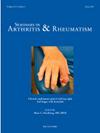Further expanding the clinical spectrum of giant cell arteritis: Non-classical organ involvement and uncommon complications
IF 4.4
2区 医学
Q1 RHEUMATOLOGY
引用次数: 0
Abstract
Objective
The increasing use of imaging techniques, particularly 18F-FDG PET-CT, together with autopsy findings, has significantly expanded our understanding of the clinical spectrum of giant cell arteritis (GCA). This study aimed to assess the frequency and spectrum of non-classical manifestations and other infrequent complications of the disease
Methods
This retrospective study analyzed a consecutive cohort of 174 patients with proven GCA diagnosed between 2005 and 2024.
Results
Among 174 GCA patients, 52 (29.9%) presented with one or more non-classical organ manifestations, including cardiac involvement in 7.5% (ischaemic heart disease or pericarditis), primary respiratory disease in 13.8% (pleural disease, sore throat, persistent dry cough, interstitial lung disease, and pulmonary inflammatory nodules), neurological complications beyond strokes in 2.3% (peripheral neuropathy, epilepsy, and spinal cord infarction), gastrointestinal involvement in 1.1%, and increased 18F-FDG uptake in salivary glands in 5.7%. Beyond these manifestations, PET-CT at diagnosis revealed uncommon medium-to-large vessel involvement, including renal artery vasculitis in 2.9% (without renal insufficiency or urinary abnormalities) and asymptomatic splanchnic involvement (coeliac trunk or superior mesenteric artery) in 4.6%. Other infrequent manifestations included secondary amyloidosis in 1.1%, necrosis or involvement of the scalp, tongue, or lips in 2.3%, carotidynia in 5.2%, overt audiovestibular involvement (including sensorineural hearing loss or vestibular dysfunction) in 3.4%, musculoskeletal symptoms beyond PMR in 10.3% (peripheral arthritis and remitting distal extremity swelling with pitting oedema), diffuse increase in bone marrow 18F-FDG uptake in 15.5%, and polyautoimmunity in 10.3%.
Conclusion
Beyond the classical cranial and extracranial patterns, which often coexist, a significant proportion of GCA patients may present with atypical or non-classical complications, sometimes as the initial manifestation. These should be considered during evaluation and follow-up, as early recognition and treatment are key to reducing morbidity and mortality.
进一步扩大巨细胞动脉炎的临床范围:非典型性器官受累和罕见并发症
越来越多的影像技术,特别是18F-FDG PET-CT,以及尸检结果,极大地扩展了我们对巨细胞动脉炎(GCA)临床谱的理解。本研究旨在评估该疾病的非经典表现和其他罕见并发症的频率和频谱。方法:本回顾性研究分析了2005年至2024年间诊断为GCA的174例连续队列患者。结果在174例GCA患者中,52例(29.9%)表现出一种或多种非经典器官表现,包括7.5%的心脏受累(缺血性心脏病或心包炎),13.8%的原发性呼吸系统疾病(胸膜疾病、喉咙痛、持续性干咳、肺间质性疾病和肺炎性结节),2.3%的神经系统并发症(周围神经病变、癫痫和脊髓梗死),1.1%的胃肠道受累。涎腺18F-FDG摄取增加5.7%。除这些表现外,PET-CT诊断时显示罕见的中大血管受累,包括肾动脉血管炎(2.9%)(无肾功能不全或尿路异常)和无症状的内脏受累(腹腔干或肠系膜上动脉)(4.6%)。其他不常见的表现包括继发性淀粉样变(1.1%),头皮、舌头或嘴唇坏死或受累(2.3%),颈动脉痛(5.2%),明显的听觉前庭受累(包括感音神经性听力丧失或前庭功能障碍)(3.4%),PMR以外的肌肉骨骼症状(外周关节炎和缓解的远端肿胀伴点状水肿)10.3%,骨髓弥漫性增加18F-FDG(15.5%)和多自身免疫(10.3%)。结论GCA患者除了常伴有典型的颅脑和颅外病变外,还可能出现非典型或非典型并发症,有时为首发表现。在评估和随访期间应考虑这些因素,因为早期识别和治疗是降低发病率和死亡率的关键。
本文章由计算机程序翻译,如有差异,请以英文原文为准。
求助全文
约1分钟内获得全文
求助全文
来源期刊
CiteScore
9.20
自引率
4.00%
发文量
176
审稿时长
46 days
期刊介绍:
Seminars in Arthritis and Rheumatism provides access to the highest-quality clinical, therapeutic and translational research about arthritis, rheumatology and musculoskeletal disorders that affect the joints and connective tissue. Each bimonthly issue includes articles giving you the latest diagnostic criteria, consensus statements, systematic reviews and meta-analyses as well as clinical and translational research studies. Read this journal for the latest groundbreaking research and to gain insights from scientists and clinicians on the management and treatment of musculoskeletal and autoimmune rheumatologic diseases. The journal is of interest to rheumatologists, orthopedic surgeons, internal medicine physicians, immunologists and specialists in bone and mineral metabolism.

 求助内容:
求助内容: 应助结果提醒方式:
应助结果提醒方式:


